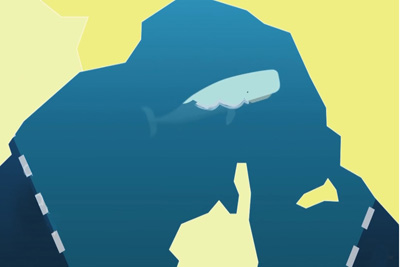The Project
Background

The Pelagos Sanctuary for Mediterranean Marine Mammals is a special marine protected area in the north-western Mediterranean Sea. It is located between Liguria, France and Sardinia and covers an area of around 90 000 km2. The sanctuary is the most important breeding and feeding site for cetacean populations living in the Mediterranean Sea and thus crucial for their well-being. Distinct ecological and sea floor conditions in the sanctuary mean that primary production (the creation of organic compounds through photosynthesis or chemosynthesis) in the area is very high and supports a diversified food chain.
The unique seabed features in the area, such as canyons, attract a large number of sperm whales that often emerge near the coast. Major commercial, tourist and industrial sites are also located in the area and marine traffic (e.g. passenger, cargo and fishing boats) increases particularly during the summer, when the presence of sperm whales is higher. Collisions and injured animals are consequently frequent and have a very high negative impact on the species, whose Mediterranean sub-population counts at just 2 500 mature individuals.
Objectives
The project has developed an interference avoidance system aimed at detecting and tracking sperm whales; identifying threats to them; and preventing collisions and other risks by issuing warning messages in real time to ships in the area. A protocol for reducing the disturbance and impact risks has been drafted in cooperation with the local coast guard and agreed by all stakeholders involved. After receiving the warning message, ships will be invited to apply this protocol and the coast guard will supervise its application. The system is innovative because it prevents ship impacts with the whales by monitoring and tracking the animals underwater, by acoustic means. This aspect is vital, considering sperm whales spend three quarters of their time underwater.
To summarise, the expected results were:
- Implementation of an active conservation tool, suitable for replication in other areas of the Mediterranean Sea;
- Reduction of ship collision risks and stress derived from noise pollution from marine traffic for sperm whales in the selected area;
- Definition of specific regulations and strategies to prevent ship collisions;
- An increase in public awareness concerning the threats affecting cetaceans in the Pelagos Sanctuary; and
- Implementation of a database of cetacean sightings that can be easily consulted and used for management, conservation and public dissemination purposes.
The system was active during the summer-autumn season for a total of 177 days over a three-year period. During this period, the presence of Sperm whales was noted on five distinct days with an average of 1 Sperm whale per month. More than 5,000 Sperm whale clicks were observed that allowed the complete reconstruction of four dives. The presence of these Sperm whales in the area has never been anticipated by visual observations. In one case the sperm whales were observed a posteriori thanks to WHALESAFE's indications regarding their position. This is the best result of the project: we have shown that thanks to listening to the clicks it is possible to know in advance the presence and position of the animals thus allowing to intervene by informing the ships and applying the protocol of conduct! Only in this way the risk of collisions can be drastically reduced.
Unfortunately, the storm of the 29th October 2018 destroyed the acoustic system and the project came to a stop.

